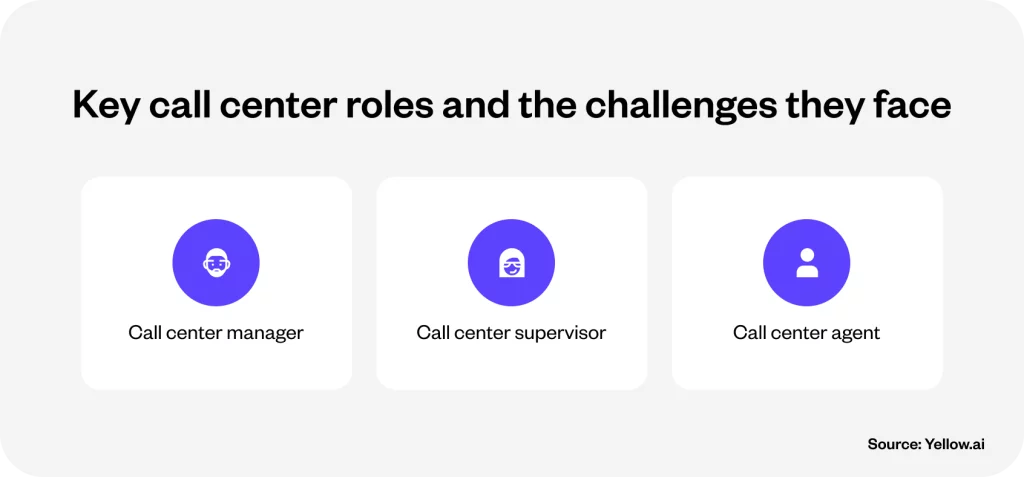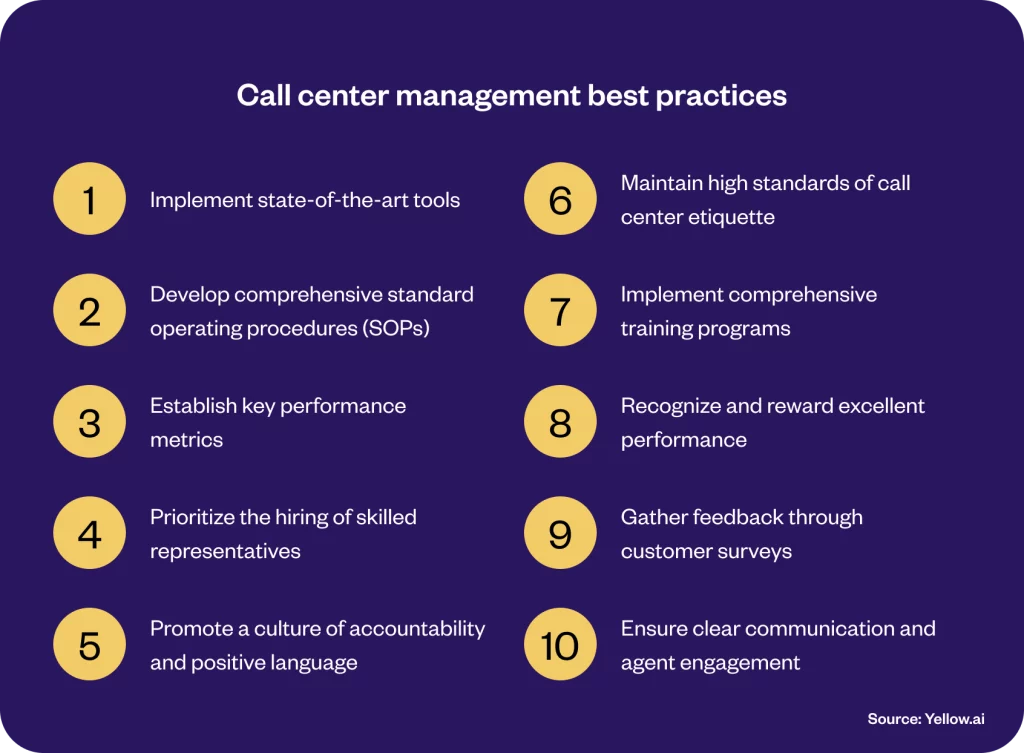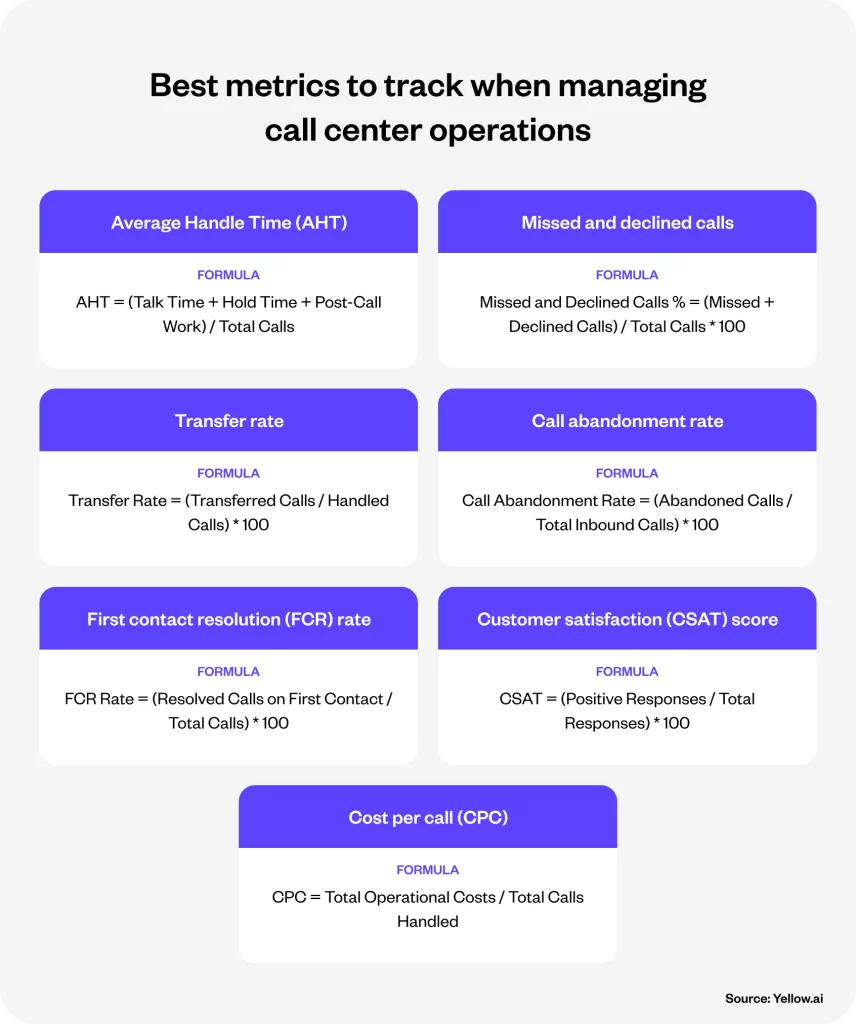Executive summary
Dive into the heart of efficient call center management with our expert guide. This blog explores the top principles that drive successful call center operations, from leveraging advanced technology to fostering agent skill development. Discover how to elevate your call center’s performance, ensuring a seamless customer experience that meets and surpasses expectations. Perfect for call center managers aiming to refine their operational strategies and enhance customer satisfaction.
Managing a call center is like conducting a complex task; each element, from technology to personnel, must harmonize to create a seamless customer experience. As businesses evolve, the call center’s role has become increasingly pivotal, not just as a customer service point but as a strategic asset that shapes customer perceptions and influences loyalty. In the fast-paced world of call center operations, managers face the challenge of balancing efficiency with exceptional service. It is a task that demands adherence to certain fundamental principles.
The landscape of call center operations is undergoing a transformation driven by technological advancements and a deeper understanding of customer behavior. Modern call centers are no longer just about handling calls but strategic hubs that enhance customer journeys through smart technology and human empathy. As we explore the 10 key principles for managing call center operations, we also explore the burgeoning role of call center automation, showcasing how AI and machine learning are present-day necessities in streamlining operations and elevating customer service standards. By 2027, the world market for AI in call centers is expected to be worth more than $4 billion.
Related must-reads:
- Call center automation – Types, benefits and steps to implement
- Customer service in a call center: A detailed guide
- 31 Call center metrics and KPIs to enhance the CX
- Call center software – A Complete Guide [2024]
What is call center management?
Call center management is the strategic orchestration of people, processes, and technology to ensure the effective and efficient operation of a call center. It’s about steering the team towards delivering exceptional customer service while optimizing operational efficiency. This management discipline involves a comprehensive understanding of the operational components of a call center, including staff recruitment, training, performance monitoring, and technology integration to facilitate seamless customer interactions.
At its core, call center management is about balancing customer satisfaction and operational efficiency. Managers must navigate the intricacies of workforce management, ensuring agents are well-equipped, motivated, and aligned with the company’s service standards and goals. It includes deploying the right mix of technology solutions, from automated call distribution systems to customer relationship management (CRM) software, to support the team’s effective handling of customer queries.
The significance of call center management extends beyond mere operational oversight. It is pivotal in shaping the customer experience, impacting brand perception, and driving business growth. Effective call center management ensures that customer interactions are handled with care, professionalism, and efficiency, increasing customer loyalty and retention. In today’s competitive landscape, where customer service can be a significant differentiator, mastering call center management is imperative for businesses aiming to excel in customer engagement and operational excellence.
Key call center roles and the challenges they face
In the bustling world of call centers, a harmonious interplay among various roles is crucial for achieving customer satisfaction and operational excellence. Each role, distinct in its responsibilities and challenges, forms the backbone of call center operations. Let’s explore the key roles within a call center and the unique challenges they face, providing a clear understanding for businesses looking to optimize their call center functions.

1. Call center manager
The Call Center Manager holds the reins, steering the entire operation toward success. This pivotal role involves overseeing daily activities and shaping the call centre’s broader strategic direction. Managers align the center’s goals with the company’s vision, ensuring a seamless customer experience and efficient resource utilization.
Duties and challenges:
- Setting and communicating clear objectives for the call center aligning with business goals.
- Navigating the complexities of workforce management, including scheduling and performance monitoring.
- Continuously assessing and integrating new technologies to enhance efficiency and customer satisfaction.
- Maintaining compliance with industry regulations, ensuring all operations adhere to legal standards.
2. Call center supervisor
Acting as the bridge between management and agents, Call Center Supervisors play a critical role in translating strategic directives into actionable tasks. They are directly responsible for maintaining high levels of customer satisfaction by closely monitoring agent performance, providing real-time coaching, and ensuring adherence to best practices.
Duties and challenges:
- Conducting regular training sessions to keep agents updated on products and service protocols.
- Monitoring call quality to identify areas for improvement and ensure compliance with standards.
- Handling escalated calls, offering a higher level of problem-solving to satisfy customer needs.
- Balancing team morale and productivity, fostering a positive and productive work environment.
3. Call center agent
Agents are the frontline warriors of a call center. They interact directly with customers and shape the latter’s perception of the brand. They handle a wide array of tasks, from addressing customer inquiries to resolving complaints, requiring a deep understanding of the company’s offerings and strong communication skills.
Related read: Call center agents – Responsibilities, skills & challenges
Duties and challenges:
- Delivering consistent, high-quality customer service in line with company policies and standards.
- Adapting to varying customer temperaments and demands, maintaining professionalism under pressure.
- Utilizing CRM and other call center tools efficiently to manage customer interactions effectively.
- Providing feedback to supervisors and managers on call trends and potential areas for process improvement.
Call center management best practices
Effective call center management is crucial for providing excellent customer service and achieving operational efficiency. Implementing best practices can significantly enhance call centers’ performance and productivity. Here, we delve into the key practices and their impacts, offering insights into their implementation.

1. Implement state-of-the-art tools
State-of-the-art tools in call center management include advanced software and hardware solutions that streamline operations, improve customer interactions, and increase agent productivity. These tools range from CRM systems and omnichannel communication platforms to AI-driven analytics and automation technologies. Implementing these tools helps call centers adapt to evolving customer expectations and handle interactions more efficiently. Using advanced tools can dramatically reduce response times and improve customer support accuracy.
For instance, a call center using AI-powered chatbots for initial customer inquiries can filter and direct complex issues to human agents, optimizing the workflow and allowing agents to focus on more intricate problems.
Tips for implementation:
- Evaluate and choose tools that integrate seamlessly with existing systems.
- Train staff comprehensively on new technologies to maximize their benefits.
- Regularly review and update the technology stack to stay ahead of industry trends.
2. Develop comprehensive standard operating procedures (SOPs)
SOPs are detailed, written instructions designed to achieve uniformity in the performance of specific functions. In call center management, SOPs outline the processes for handling calls, managing customer inquiries, and other operational tasks. They ensure consistency in service quality and help in training new agents. Clear SOPs can lead to improved efficiency and higher customer satisfaction.
For example, a call center with well-defined SOPs for handling customer complaints can resolve issues faster and more effectively, increasing customer loyalty and reducing churn.
Tips for implementation:
- Document all operational processes in detail.
- Regularly review and update SOPs to convey and showcase changes in business strategy or market conditions.
- Ensure all team members are trained on SOPs and understand their importance.
3. Establish key performance metrics
Defining and tracking Key Performance Metrics (KPMs) is essential for gauging the success of a call center in meeting its primary business goals. Crucial metrics such as customer satisfaction scores, average handle time, and first-call resolution rates are indispensable for call center management. These indicators are vital for evaluating the operational efficiency and overall performance of the call center, providing insights into areas that require enhancement or maintain excellence. By monitoring KPMs, managers can identify areas of improvement, allocate resources more effectively, and enhance overall service quality.
For instance, tracking the first call resolution rate can highlight additional training or resource allocation requirements to improve customer satisfaction.
Tips for implementation:
- Identify and prioritize metrics that align with business goals.
- Use real-time monitoring tools to track performance metrics.
- Regularly review and analyze data to make informed decisions and improvements.
4. Prioritize the hiring of skilled representatives
A call center’s effectiveness hinges on its staff’s capabilities and expertise. Recruiting competent representatives is crucial to providing customers with informed and adept service. This approach includes scouting for candidates with a balanced combination of technical expertise, communicative prowess, and a natural inclination for customer service.
Related read: Customer Service Representative: Skills & Strategies
Skilled representatives can significantly reduce call handling times and improve customer satisfaction levels. For instance, a company that invests in recruiting agents with strong problem-solving skills and product knowledge can see a marked improvement in first-call resolution rates.
Tips for implementation:
- Develop a clear profile of the ideal candidate, including necessary skills and experience.
- Employ targeted hiring strategies to attract qualified candidates.
- Execute a thorough screening and interview process to assess the skills and fit of potential hires.
5. Promote a culture of accountability and positive language
Creating a culture of accountability ensures that each team member comprehends their role in achieving the call center’s objectives and is responsible for their actions. Positive language and communication foster a supportive environment and enhance customer interactions. A culture of accountability and positivity can lead to increased employee engagement and customer loyalty.
For example, a call center that regularly recognizes and holds agents accountable for their performance creates an environment where employees are inspired and driven to excel and provide exceptional service.
Tips for implementation:
- Set clear expectations and responsibilities for all team members.
- Encourage open and constructive feedback.
- Recognize and reward positive behavior and high performance.
6. Maintain high standards of call center etiquette
Call center etiquette refers to the professional behavior and communication standards expected from agents. Maintaining high standards of etiquette ensures that all customer interactions are conducted respectfully, professionally, and efficiently. Adherence to etiquette standards can significantly enhance the customer experience and build trust.
For instance, agents who consistently use polite language, listen actively and respond empathetically can improve customer satisfaction and retention rates.
Tips for implementation:
- Develop and enforce a comprehensive etiquette guide covering all aspects of customer interaction.
- Train agents on the importance of etiquette in building customer relationships.
- Regularly monitor and provide feedback on agents’ adherence to etiquette standards.
7. Implement comprehensive training programs
Comprehensive training programs are essential for equipping call center agents with the necessary skills and knowledge to perform their roles effectively. These programs should cover product knowledge, customer service techniques, and the use of call center technology.
Related read: The ultimate guide to customer service training
Well-trained agents are more confident and efficient in handling customer inquiries, leading to improved customer satisfaction and reduced call times. For example, a company that regularly updates its training curriculum to include the latest product features and service protocols will have a team that can address customer needs more accurately and swiftly.
Tips for implementation:
- Develop a continuous learning environment that includes initial training, ongoing skill development, and advanced training for experienced agents.
- Use a blend of training methods, such as e-learning, workshops, and on-the-job training, to cater to different learning styles.
- Regularly assess training effectiveness and make adjustments to ensure it meets the call center and its customers’ evolving needs.
8. Recognize and reward excellent performance
Recognizing and rewarding excellent performance is crucial for motivating call center agents and reinforcing positive behaviors. This practice helps build a motivated workforce committed to achieving high service standards. A reward system acknowledging outstanding performance can increase job satisfaction, lower turnover rates, and higher productivity.
For instance, a call center that implements a monthly recognition program for top performers often sees an uplift in overall team performance and morale.
Tips for implementation:
- Establish clear criteria for what constitutes excellent performance.
- Implement a variety of recognition and reward mechanisms, such as bonuses, certificates, public acknowledgment, or career advancement opportunities.
- Ensure that the recognition program is fair and transparent, with regular opportunities for all agents to be recognized for their contributions.
9. Gather feedback through customer surveys
Collecting feedback through customer surveys is vital for understanding customer satisfaction and identifying areas for improvement. This feedback provides direct insights into the customer’s experience and perception of the call center’s service. Regularly gathering and analyzing customer feedback can lead to targeted improvements in service delivery and customer experience.
For example, a call center that implements a feedback loop and acts on the insights can enhance service quality, leading to higher customer retention and loyalty.
Tips for implementation:
- Implement a systematic approach to collecting feedback after customer interactions.
- To increase response rates, use various survey methods, such as phone, email, or SMS surveys.
- Analyze the feedback to identify trends and areas for improvement and use this information to inform training and operational strategies.
10. Ensure clear communication and agent engagement
Clear communication and high levels of agent engagement are fundamental to the successful operation of a call center. Effective communication ensures that agents are well-informed and aligned with the call center’s goals and policies, while engagement drives motivation and commitment. A call center that prioritizes clear communication and agent engagement often experiences lower absenteeism and turnover rates, as well as higher customer satisfaction.
For instance, regular team meetings and open forums for agents to voice concerns and suggestions can lead to a more cohesive and committed workforce.
Tips for implementation:
- Maintain regular, open, and transparent communication channels between management and agents.
- Encourage agent participation in decision-making processes and give them a voice in shaping their work environment.
- Implement engagement initiatives, such as team-building activities or career development opportunities, to keep agents motivated and committed to their roles.
Best metrics to track when managing call center operations
Navigating the intricate world of call center operations necessitates a deep dive into metrics that reveal the heartbeat of customer service interactions. In a landscape where every call counts, tracking the right metrics is akin to having a GPS for managing customer experiences. It guides businesses in fine-tuning their strategies, optimizing agent performance, and achieving a harmonious balance between efficiency and customer satisfaction. Let’s explore the pivotal metrics that steer call center operations toward excellence.

1. Average Handle Time (AHT)
Average Handle Time (AHT) measures the total time an agent spends on a call, including talk time, hold time, and post-call tasks. It’s a critical metric for assessing efficiency and operational speed in resolving customer issues. A lower AHT indicates efficient call resolution and effective customer service, allowing agents to handle more calls and reduce customer wait times. For instance, a call center that reduces its AHT from 10 to 8 minutes can handle more calls without increasing staff.
Formula and calculation
To calculate AHT, sum the talk time, hold time, and post-call work time, then divide by the total number of calls.
Formula: AHT = (Talk Time + Hold Time + Post-Call Work) / Total Calls
Example: If an agent has 300 minutes of talk time, 60 minutes of hold time, and 140 minutes of post-call work over 100 calls, AHT = (300 + 60 + 140) / 100 = 5 minutes.
2. Missed and declined calls
This metric tracks calls that are not answered or are declined by agents, indicating potential gaps in staffing or call routing efficiency. According to a survey, there are an average of 4,400 calls every month that a call center handles, with 48 of those calls going unanswered. Tracking missed and declined calls helps identify peak times or inefficiencies, guiding improvements in staffing and training. For example, a high rate of missed calls may signal the need for more agents during certain hours.
Formula and calculation
Calculate by dividing the total number of missed and declined calls by the total number of incoming calls, multiplied by 100.
Formula: Missed and Declined Calls % = (Missed + Declined Calls) / Total Calls * 100
Example: If there are 50 missed and declined calls out of 1,000 total, the rate is (50/1,000) * 100 = 5%.
3. Transfer rate
The transfer rate measures the percentage of calls transferred to another agent or department, reflecting the call routing accuracy and agent skill set alignment. A high transfer rate can indicate routing issues or a lack of agent expertise, affecting customer satisfaction. Improving routing algorithms can reduce the transfer rate and enhance first-contact resolution.
Formula and calculation
Determine by dividing the number of transferred calls by the total number of handled calls, multiplied by 100.
Formula: Transfer Rate = (Transferred Calls / Handled Calls) * 100
Example: If 200 out of 2,000 calls are transferred, the transfer rate is (200 / 2,000) * 100 = 10%.
4. Call abandonment rate
This metric shows the percentage of callers who hang up before reaching an agent, indicating potential issues with wait times or call handling efficiency. Reducing the call abandonment rate can improve customer satisfaction and retention. For example, implementing callback options during peak hours can decrease abandonment rates and enhance customer experience.
Formula and calculation
Calculate by dividing the total number of abandoned calls by the total number of incoming calls.
Formula: Call Abandonment Rate = (Abandoned Calls / Total Inbound Calls) * 100
Example: With 150 abandoned calls out of 3,000 total inbound calls, the rate is (150 / 3,000) * 100 = 5%.
5. First contact resolution (FCR) rate
FCR rate is the percentage of customer inquiries resolved during the first interaction without the need for follow-up. It reflects the effectiveness of agents in addressing customer needs promptly. A high FCR rate signifies efficient problem-solving capabilities and contributes to higher customer satisfaction and loyalty. For example, improving agent training to increase FCR can lead to fewer repeat calls and greater customer retention.
Formula and calculation
FCR is calculated by dividing the number of calls resolved on the first contact by the total number of calls.
Formula: FCR Rate = (Resolved Calls on First Contact / Total Calls) * 100
Example: If 400 out of 500 calls were resolved on the first contact, FCR rate = (400 / 500) * 100 = 80%.
6. Customer satisfaction (CSAT) score
CSAT score measures customer satisfaction with their call center experience. It is often gathered through post-call surveys. CSAT is a direct indicator of customer perception and loyalty. Improving CSAT can enhance brand reputation and customer retention. For instance, tailoring services to customer feedback can lead to increased CSAT scores.
Formula and calculation
CSAT is calculated by dividing the number of satisfied customers by the total number of survey responses and then multiplying by 100.
Formula: CSAT = (Positive Responses / Total Responses) * 100
Example: If 300 out of 350 survey responses are positive, CSAT = (300 / 350) * 100 = 85.7%.
7. Cost per call (CPC)
CPC quantifies the average cost associated with handling a call, encompassing operational expenses like labor, technology, and overhead. Managing CPC efficiently ensures the call center’s profitability and sustainability. Lowering the CPC, for instance, through process optimization and technology, can reduce overall operational costs while maintaining service quality.
Formula and calculation
CPC is determined by dividing the total operational costs by the number of calls handled.
Formula: CPC = Total Operational Costs / Total Calls Handled
Example: If the total cost is $50,000 and 25,000 calls are handled, CPC = $50,000 / 25,000 = $2 per call.
Key takeaways – Call center automation is the future.
As we navigate the complex domain of call center operations, the spotlight inevitably turns toward the transformative power of automation. By 2026, experts predict that around 10% of agent interactions will be automated, a fivefold increase from the current rate. The future is unmistakably digital, with call center automation emerging as the linchpin in the quest for operational excellence and unmatched customer satisfaction. In this dynamic realm, Yellow.ai stands out as a leader in innovation, offering a comprehensive suite of tools that redefine efficiency and effectiveness in call center management. With its advanced AI-driven solutions, Yellow.ai empowers centers to streamline processes, reduce average handle times, and elevate the customer experience to new heights.
To witness how your call center achieves excellence, book a demo with Yellow.ai.
Harnessing the capabilities of Yellow.ai, businesses can unlock a world where intelligent virtual assistants and machine learning algorithms predict customer needs, automate routine inquiries, and free human agents to handle more complex issues. This seamless integration of human empathy and AI efficiency ensures that each customer interaction becomes an opportunity to build loyalty and drive growth. As we look to the future, embracing the power of call center automation with Yellow.ai isn’t just a strategic move—it’s a leap toward setting new benchmarks in customer service and operational success.






















